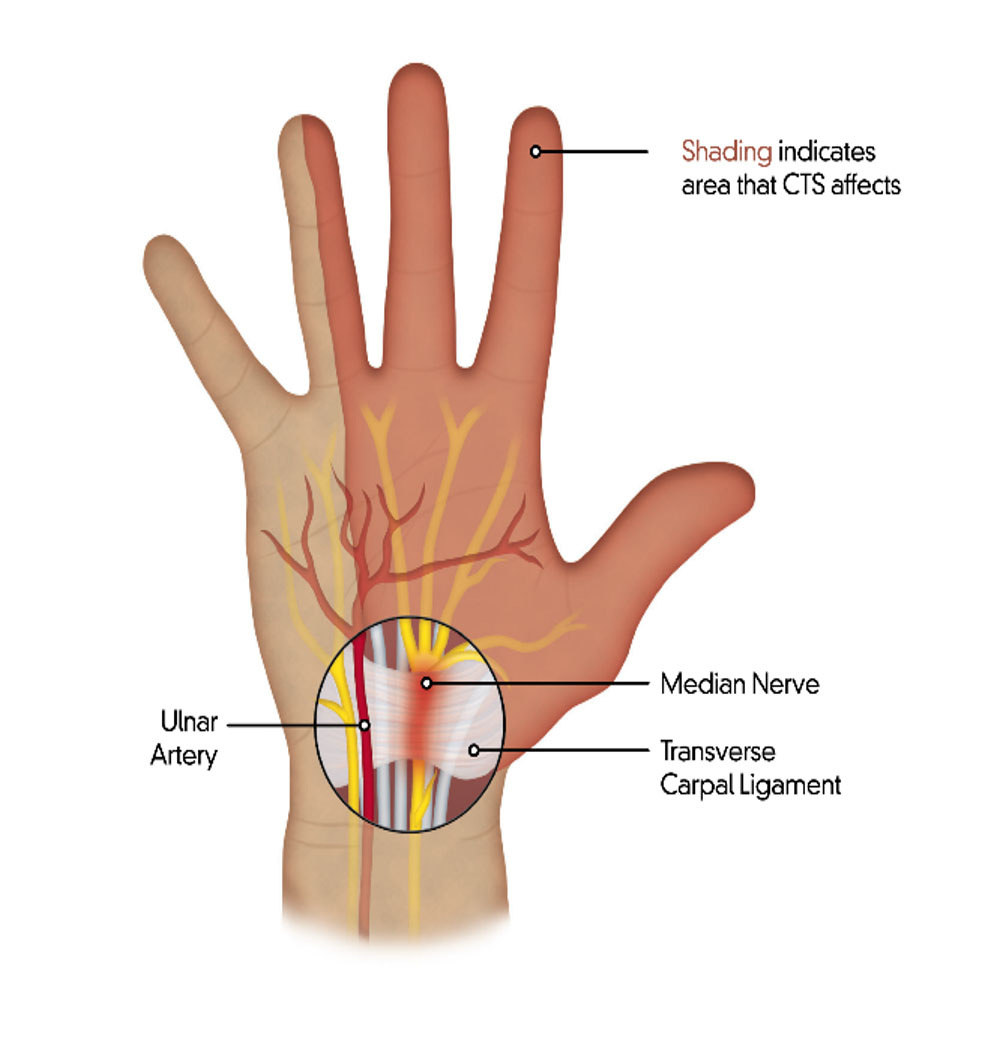Carpal Tunnel Syndrome (CTS) is a common condition that affects an estimated 13 million Americans. CTS causes pain, numbness, and tingling in the hand and arm [Wipperman & Penny, 2024; Wipperman & Goerl, 2016; Padua et al, 2023].
CTS occurs when one of the major nerves in the hand, the median nerve, is compressed as it travels through the wrist. It can become compressed due to various factors, including repetitive wrist movements, trauma, or anatomical variations.
The median nerve controls movement in the thumb and feeling in the thumb and first three fingers. It runs down the arm and forearm, passes through the carpal tunnel at the wrist, and continues into the hand.
Symptoms often occur when holding onto something, such as a steering wheel or phone. Symptoms can also occur at night, and patients will often describe a numb sensation and pain waking them in the middle of the night. Weakness in the hand can cause people to drop objects [Wipperman & Penny, 2024; Wipperman & Goerl, 2016; Milano et al, 2025]..

Carpal Tunnel Syndrome (CTS) can be influenced by various risk factors, both personal and occupational.
Anatomical factors: Sometimes the anatomy of your wrist can cause you to be at a higher risk, such as a smaller carpal tunnel or if you have had a previous injury that deforms the bones in the wrist.
Female gender: Carpal tunnel syndrome (CTS) is generally more common in women, which could be explained by the smaller size of the carpal tunnel.
Chronic illnesses: Some chronic illnesses (i.e. diabetes), thyroid disorders, and inflammatory conditions (i.e. rheumatoid arthritis) can put you at an increased risk of developing CTS.
Obesity/Pregnancy: Other factors can include obesity and/or fluid retention during pregnancy/menopause.
Workplace factors:Workplace factors include jobs that require prolonged or repetitive flexing of the wrist, and this may create harmful pressure on the median nerve. Examples include working in an assembly line, or more commonly, working at a desk with your wrist in a flexed position at your keyboard or mouse.
Watch your form and adjust your workstation to improve wrist positioning while working and take short frequent breaks.
Carpal tunnel syndrome is a clinical diagnosis and symptoms, physical exam findings and and nerve study (EMG/NCS) can be used to help diagnose CTS. Very commonly, the median nerve is compressed and that causes the electrical impulses to slow down when traveling through the carpal tunnel.
Ultrasound has recently been used to measure thickening of the median nerve and has been shown to be useful as a diagnostic method for CTS. The main advantages of ultrasonography are that it is simple, quick, non-invasive test that does not require needles and can be preformed the same day as your consultation.
Traditionally, CTS is managed conservatively with activity modification (i.e. avoiding activities that make the symptoms worse), adjusting posture and positioning of the wrists, taking frequent breaks and braces to provide better positioning and avoiding wrist flexion.
This minimally invasive treatment option frees up compressed nerves and has been shown to be helpful for carpal tunnel syndrome.
Carpal Tunnel Release with the SX-One MicroKnife® and ultrasound guidance
CTR using ultrasound guidance relieves the symptoms of carpal tunnel syndrome while minimizing recovery time. Most patients can return to work and the activities they love in 3-6 days. Performing CTR with ultrasound guidance allows most patients to enjoy immediate motion so they can focus on getting back to their lives and the activities they love.
Endoscopic Carpal Tunnel Release
When conservative management fails, patients are often offered traditional open carpal tunnel release surgery. Surgery involves cutting the transverse carpal ligament to relieve pressure on the median nerve. Traditional surgical techniques can resolve CTS, but may result in large and painful scars, ongoing palm pain and a longer recovery. Surgery can be open with an incision in the palm of your hand or endoscopic surgery using a camera to look inside the carpal tunnel and making an incision along the ligament.
Milano ME, Pennington MV, Ilyas AM. Diagnosis and Management of Carpal Tunnel Syndrome During Pregnancy. Obstet Gynecol. 2025 Apr 1;145(4):439-448.
Padua L, Cuccagna C, Giovannini S, Coraci D, Pelosi L, Loreti C, Bernabei R, Hobson-Webb LD. Carpal tunnel syndrome: updated evidence and new questions. Lancet Neurol. 2023 Mar;22(3):255-267.
Wipperman J, Goerl K. Carpal Tunnel Syndrome: Diagnosis and Management. Am Fam Physician. 2016 Dec 15;94(12):993-999.
Wipperman J, Penny ML. Carpal Tunnel Syndrome: Rapid Evidence Review. Am Fam Physician. 2024 Jul;110(1):52-57..